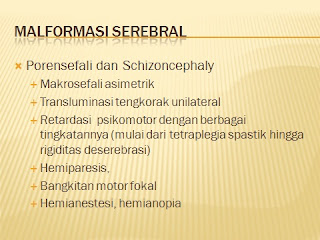CHAPTER I.
INTRODUCTION
Congenital DISORDERS
Congenital abnormalities need to be recognized by physicians and health personnel'll be detected early and treated optimally. surgeon should be concentrated on congenital abnormalities because many congenital abnormalities requiring surgical intervention. Congenital abnormalities are abnormalities in the growth of the baby structures that arise from the conception of life hasiI egg. Congenital abnormalities can be an important cause of abortion, stillbirth or death shortly after birth. Infant mortality in the first months of life are often caused by congenital abnormalities severe enough, it seemed to be a alamu selection on the survival of babies born. Babies born with major abnormalities kongenitaI, generally will be born as low birth weight babies are often even as a small baby to her pregnancy. Low birth weight infants with severe congenital abnormalities, approximately 20% die within the first week of life. Besides the physical examination, radiological and laboratory to establish the diagnosis of congenital abnormalities after birth, also known as the pre diagnosisi / - ante natal congenital anomalies with some specific ways such as ultrasound examinations, the examination of amniotic fluid and fetal blood
A. Figures Genesis
Congenital abnormalities in newborn infants may be one type of abnormality can also be the only or multiple congenital abnormalities simultaneously as multiple congenital anomalies.Sometimes a congenital abnormality has not been found or not visible at the time the baby is born, but recently discovered some time after birth. In contrast to the advances in medical technology, sometimes a congenital abnormality known during fetal life. If found one major congenital abnormalities in newborn babies, need to alert the possibility of congenital abnormalities elsewhere. It is said that when we find two or more minor congenital anomalies, major congenital abnormality likely ditetemukannya elsewhere by 15% whereas if found three or more minor congenital anomalies, the possibility of major congenital abnormalities detected by 90%.
The incidence of major congenital abnormalities ranging from 15 per i000 birth prevalence of this would be 4-5% biIa infants followed until age 1 year. Hospital Dr. Cipto Mangunkusumo (I975-1979), is clinically found the incidence of congenital abnormalities among as many as 225 babies in 19 832 live births, or by 11.6 I per 1000 live births, while in the Hospital Dr. Pirngadi, Medan (1977-1980) of 48 infants (0.33%) among 14 504 births at the Hospital and University of Gadjah Mada University (1974-1979) of tri 1.64da 4625 births. The incidence and types of congenital abnormalities can be different for different races and ethnicities, as well as be able to depend on how large the calculation keciInya congenital abnormalities.
Etiology B.Faktor
Direct cause of congenital anomalies are often difficult to know. FetaI embryonal growth and is influenced by various factors such as genetics, environmental factors or both factors simultaneously.
Some of the suspected etiological factors may influence the occurrence of congenital abnormalities among others:
[1] Genetic abnormalities and chromosomes.
Genetic abnormalities in the father or the mother is likely to influence the congenital abnormalities in children. Among these abnormalities have a regular follow Mendel's laws, but can also be inherited by the child in question as the dominant element ("dominant traits") or sometimes as a recessive element. DaIam investigations it is often difficult, but the same congenital abnormalities in the offspring can help selanjutya steps.
With advances in medical technology dafam, it has to be examined the possibility of chromosomal abnormalities during fetal life and has to consider further actions. Some examples kelainankhromosom autosomai as trisomy 21 Down syndrome (mongolism) as a sex chromosome abnormalities in Turner syndrome.
[2] mechanical factors
Mechanical stress on the fetus during intrauterine life may cause abnormalities of organs hentuk to cause deformity cersebut organ. Predisposing factor in the growth of the organ itself will facilitate the occurrence of the deformity of an organ. For example, organ deformity is talipes abnormalities in talipes varus sepcrti foot, talipes valgus, talipes equinus and talipes equinovarus (clubfoot)
[3] Factors infection.
Infection that can cause congenital abnormalities was an infection that occurred in the period of organogenesis in the first trimester of pregnancy. The presence of certain infections in the period of organogenesis can cause interference in the growth of an organ collapse. Infection in the first trimesrer on the side can cause congenital abnormalities may also increase the likelihood of abortion. As an example of a viral infection in the first trimester is oleb Rubella virus infection.Babies born to mothers suffering from rubella infection in the first trimester may have congenital abnormalities of the eye as the cataract, abnormalities in the auditory system as the deaf and the discovery of congenital heart defects. Several other infections in the first trimester can cause congenital abnormalities such as viral infection is cytomegalovirus, toxoplasmosis infection, congenital abnormalities that may be encountered is the presence of growth disturbance in the central nervous system such as hydrocephalus, mikrosefalus, or mikroftalmia.
[4] Factors Drugs
Several types of drugs, that pregnant women drink in the first trimester of pregnancy supposedly is very closely related to the occurrence of congenital abnormalities in babies. One type of drug that has been known to cause congenital abnormalities dagat is thalidomide which may result in fokomelia or mikromelia. Several types of herbs that drunk young pregnant women with unfavorable goal also allegedly close relationship with the occurrence of congenital abnormalities, although this is a laboratory has not been widely known for certain. We recommend that during pregnancy, especially the first trimester, avoid the use of drugs that are not necessary at all, although it is sometimes difficult to avoid because the mother was forced to take medication. It is for example the use of trankuilaiser for certain diseases, the use of cytostatic or hormone prepaat inevitable; these circumstances should be considered as well as possible before pregnancy and their consequences for the baby.
[5] maternal age factor
It is known that mongoIisme more common in babies born to women who approach menopause. In the newborn ward Dr Cipto Mangunkusumo Hospital in 1975-1979, found the incidence of clinically mongolism 1.08 per 100 live births and found a relative risk of 26.93 for the group of mothers aged 35 years or more; figures state that found is 1: 5500 for the group of mothers aged <35 years, 1: 600 for groups of women aged 35-39 years, 1: 75 for groups of women aged 40-44 years and 1: 15 for the group of mothers aged 45 years or more.
[6] hormonal factors
Hormonal factors are thought to have links with the incidence of congenital abnormalities.Babies born to mothers with maternal hypothyroidism or diabetes mellitus is likely to experience greater growth impairment when compared with normal infants.
[7] radiation factor
Radiation there may very well be the beginning kehamiIan can cause congenital abnormalities in the fetus. A history of radiation is large enough to concern parents will be able to cause mutations in the gene are likely to cause congenital abnormalities in infants of birth.Radiation for diagnostic or therapeutic purposes should be avoided during pregnancy, especially in young women.
[8] nutritional factors
In the experimental animals, severe malnutrition during pregnancy can cause congenital abnormalities. In humans, the investigations showed that the frequency of congenital abnormalities in babies born to mothers who lack food is higher when compared with babies born to women of good nutrition. In the animal experiments, protein deficiency, vitamin A ribofIavin, folic acid, thiamin and so Iain can increase the incidence of congenital & elainan.
[9] Other factors
Many congenital anomalies of unknown cause. Factor fetal factors alone and suspected fetal environment may be a contributing factor. Social problems, hypoxia, hypothermia, or hyperthermia could be expected to be a contributing factor. Often the cause is unknown kongenitai abnormalities.





































No comments:
Post a Comment